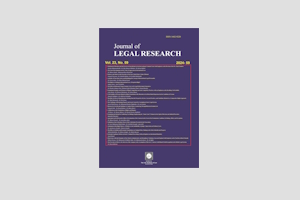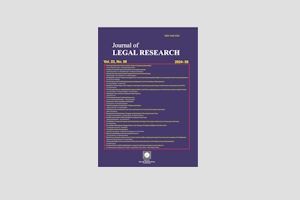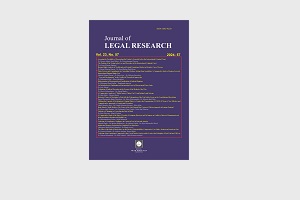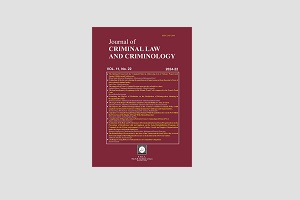Journal of
Criminal Law and Criminology
Number 23
V12 ● N23
September 2024
The Shahr -e- Danesh Institute of Law
Research and Study
(SDIL)
Managing Editor: Vahid Eshtiagh
Editor-in-Chief: Mohammad Ashoori
CONTENTS
Study of Adultery and Rape of Children in the Penal System of Iran and the United Kingdom
Sakineh Khanlarzade; Jafar Kousha; Mohammad Ali Mahdavi Sabet
Legal inconsistencies with the individualization policy of the welfare model In responding to the crimes of children and teenagers
Parizad Kavosi Khasraghi; Abdoreza Javan Ja’afari Boojnordi; Seyyed mahdi Seyyedzadeh Sani; Hossein Gholami
Electronic Signature and Crime Prevention
Saeed Pourteymour; Mohammad Ebrahim Shams Nateri
Manufacturer’s Criminal Responsibility Against off-label Drugs
Mohammad Pirvaram; Shadi Azimzadeh; Tahmores Bashirieh; Fatemeh Mohamadi Moghanjoy
Individual and Social Side Effects of Whipping Punishment
Seyed Mohammad Kazem Mousavi; Abdulvahid Zahedi
Criminological Conceptualization of State Crime
Mohammad Nazemipour; Mehrdad Rayejian Asli; Firouz Mahmoudi Janaki; Mohammadreza Elahimanesh
The Status of the Personality Profile in the criminal justice process of children and adolescents (Case study of Hamedan city)
Golnaz Hayati; Mehri barzegar
Studying the effect of fashion and media on children’s and teenagers’ delinquency and delinquency – a hybrid approach
atyeh azizi; Behzad Razavi Fard
Analysis of the effects of atmospheric temperature index on violent and financial crimes (case study of provincial centers)
ELHAM TABRIZI; razieh saberi; Mohadaseh farzam mehr
Different Approaches of the Tax Legislator Towards Recidivism
Seyed Hossein Hosseini; Hamidreza Daneshnari; mohammad karimi bandar abadi
From Protection to Re-Retributive in the Context of Criminal Responsibility of Children in the Belgian Legal System
abas tadayon
Criminological Investigation of Juvenile Criminal Behavior Caused by Object Relations
saeed mhmood Mirkhalili; Elaheh Mehrian; seyed mehdi Saberi
Study of Adultery and Rape of Children in the Penal System of Iran and the United Kingdom
Sakineh Khanlarzade
PhD student in Criminal Law and Criminology, Faculty of Law and Political Science, Research Sciences Unit, Islamic Azad University, Tehran, Iran.
Jafar Kousha
Associate Professor, Department of Criminal Law and Criminology, Faculty of Law, Shahid Beheshti University, Tehran, Iran.
Mohammad Ali Mahdavi Sabet
Assistant Professor, Department of Criminal Law and Criminology, Faculty of Law and Political Sciences, Research Sciences Unit, Islamic Azad University, Tehran, Iran.
Abstract
From the point of view of the legislator of Islamic criminal code, the existence of violence in the material element of the crime of adultery increases the punishment for women and proves the death penalty. Adultery by violence is the act of intimacy with a woman or girl against her will and agreement, whether it is to overcome her desire by threats and force. Whether it is done by distorting his consent through omission and deception. Sex with a child under the age of nine years of age if the child is deceived by sex and deceit is a rape that is punishable by the death. If the child is satisfied with adultery It is not rape that is also contemplative. British criminal law is sufficient for the development of a crime of rape under the 2003 Sexual Crime Act. A person under the age of sixteen cannot legally give sexual satisfaction, so sex with the person under that age is automatically rape without a person. That there is a need to prove coercion. Although there are many ambiguities regarding consent as a negative condition for the realization of sexual rape in the relevant regulations and judicial procedure of this country. In this article, the giving of consent to the child by the legislator has been analyzed with the analytical-descriptive method and an attempt has been made while analyzing the crime of rape Violence, the reaction against it and how to prove it should be investigated.
Keywords
Adultery، Rape، Child Victim ،Legislative Criminal Policy، Evidence
Legal inconsistencies with the individualization policy of the welfare model In responding to the crimes of children and teenagers
Parizad Kavosi Khasraghi
PhD student, criminal law and criminology, faculty of law and political science, Ferdowsi University of Mashhad, Mashhad, Iran
Abdoreza Javan Ja’afari Boojnordi
Professor, Department of Criminal Law and Criminology, Faculty of Law and Political Science, Ferdowsi University of Mashhad, Mashhad, Iran
Seyyed mahdi Seyyedzadeh Sani
Assistant Professor, Department of Criminal Law and Criminology, Faculty of Law and Political Science, Ferdowsi University of Mashhad, Mashhad, Iran
Hossein Gholami
Professor, Department of Criminal Law and Criminology, Faculty of Law and Political Sciences, Allameh Tabataba’i University, Tehran, Iran
Abstract
The main basis for differentiating responses in the crimes of children and adolescents is the commitment to the welfare model. This model aims to improve the behavioral and personality status of delinquent children and teenagers with an idealistic view and influenced by the human rights strategy. One of the main aspects of accepting the welfare-oriented model is to pay attention to the policy of individualization of answers. This principle means fitting the answer to the character of the offender. The individualization of answers will be realized through the de-authentication of non-clinical variables such as the severity and nature of the crime and the adoption of a child-oriented approach. On the other hand, the diversity of the answers, the preference of the non-incarceration alternative response over the incarceration-reducing answer, and the dominance of the new circuit alternative approach over the traditional one is one of the most important dimensions of attention to individualization. The method of this research is based on the content analysis of the Islamic Penal Code and judicial procedure. The findings of the research indicate non-adherence to the welfare model in terms of individualization in determining the response, that is, depending on the case, in punishment crimes, the model of substitution of imprisonment, and in criminal and retributive crimes, the justice model as the dominant model of punishment has been accepted for crimes against children and adolescents.
Keywords
Juvenille، Inconsistency.welfare model، individualization، Penalization
Electronic Signature and Crime Prevention
Saeed Pourteymour
PhD student in criminal law and criminology, Faculty of law, Kish International Campus, University of Tehran, Kish, Iran.
Mohammad Ebrahim Shams Nateri
Associate Professor, Department of Criminal Law and Criminology , Tehran University, Farabi Campus . Tehran, Iran.
Abstract
Electronic signature is one of the consequences of the development of technology and the expansion of the realm of legal transactions. Electronic signature is the inevitable result of the entry of information technology into the field of legal and registration transactions. The novelty of this issue in the legal framework of the society and its important role in preventing commercial fraud and registered crimes shows the importance of study and research in this field. The domain of document and real estate registration and e-commerce are two realms of consolidating ownership and coordinating the will of individuals. These two issues are among the most important mechanisms used by the government to protect the rights of citizens. Perhaps the primary purpose of electronic signature and similar processes was to speed up business transactions, but electronic signature can be considered as one of the factors of crime prevention now. Accurate understanding of this process requires accurate knowledge of two issues: The nature and process of electronic signature and prevention quality and requirements.
In this article, in addition to knowing the connection between these two facts, the author seeks to know the factors that increase the effect of electronic signature on crime prevention.
Keywords
Electronic Signature، Crime Prevention، Crime Prevention Theories، Registratio Crime، Data Message،Electronic Document
Manufacturer’s Criminal Responsibility Against off-label Drugs
Mohammad Pirvaram
PhD student in criminal law and criminology, Faculty of Law and Political Science, South Tehran Branch, Islamic Azad University, Tehran, Iran
Shadi Azimzadeh
Assistant Professor, Department of Law, Faculty of Law and Political Science , South Tehran Branch Islamic Azad University, Tehran, Iran.
Tahmores Bashirieh
Assistant Professor, Department of Criminal Law and Criminology, Faculty of Law and Political Science, Allameh Tabataba’i University, Tehran, Iran
Fatemeh Mohamadi Moghanjoy
Assistant Professor, Department of Criminal Law and Criminology, School of Law and Political Science, South Tehran Branch, Islamic Azad University, Tehran, Iran
Abstract
Sub-prescription is the recommendation of a drug for a disease which is not approved by supervising organizations for treating that disease. Such prescription is taken into consideration in recent events of Covid-19. One of the most effective methods in this field is the requirement of drug prescription based on the approved method. This method deals with the issue of sub-prescription of drugs and the necessary plans to deal with it, including criminal protections. It has become an executive law in countries such as the United States and the European Union because the large profits from selling drugs to patients and medical centers by pharmacies and encouraging doctors to receive cash and non-cash gifts as a result of the sale of these products will always result in the risk of prescribing drugs unrelated to the patient’s illness. In this article, an attempt has been made to measure the place of sub-prescription of drugs in the criminal policy, clarify their commonalities and differences, and provide suggestions to eliminate possible gaps and attract the legislator’s attention to the lack of an explicit law in this regard in the Iranian criminal policy. Studying the legal system of other countries and their criminal policy in facing this issue is the main method of this article. This research is a fundamental-applied study and is carried on based on descriptive and analytical methods with library tools, and its interdisciplinary analyzes lead to suggestions for enriching Iran’s legal system and clarifying criminal liability in cases of health crises.
Keywords
Criminal Liability، Criminal Policy ،Sub-Prescription Drug، Criminal Responses، Substitution Requirement
Individual and Social Side Effects of Whipping Punishment
Seyed Mohammad Kazem Mousavi
M.A. Department of Criminal Law and Criminology and Faculty of Law and Political Science, Islamic Azad University of South Tehran, Tehran, Iran.
Abdulvahid Zahedi
Assistant Professor, Doctoral degree, Department of Criminal Law and Criminology and Faculty of Law and Political Science, Islamic Azad University, South Tehran Branch, Tehran, Iran.
Abstract
Whipping punishment has been used throughout history in response to crime and has faced many objections and criticisms. Some jurists consider this punishment to be against human dignity and dignity, violating human rights, ineffective, and causing the escalation of violence and individual and social deviations. On the other hand, the supporters of whipping from a religious and legal point of view consider whipping to be in accordance with Shari’a rules, in accordance with public order, effective and expedient. Considering that whipping is one of the punishments that is implemented in Iran and this punishment has been criticized by international institutions, it is necessary to analyze and evaluate the whipping of criminals from different angles, especially from the criminological, psychological and sociological point of view. Using the descriptive-analytical method and using library resources, this article tries to answer the question that to what extent whipping is effective and consistent with the philosophy of punishment? And what are the reasons for the supporters and opponents of flogging? This research first examines the history and basics of whipping punishment, then by analyzing the effects and consequences of whipping punishment on individuals and society, it tries to arrive at the hypothesis that whipping punishment cannot be effective in reforming and rehabilitating criminals, and in general, everything derived from the new approach of punishment philosophy It is not proven in the application of whipping punishment.
Keywords
Individual ،Social ،Side Effects، Whip، Punishment
Criminological Conceptualization of State Crime
Mohammad Nazemipour
PhD student, Department of Criminal Law and Criminology, Faculty of Humanities, North Tehran Branch, Islamic Azad University, Tehran, Iran
Mehrdad Rayejian Asli
Assistant professor, faculty member, Department of Law, Humanities Research and Development Institute (Samt) and Visiting Professor, Department of Law, Faculty of Humanities, North Tehran Branch, Islamic Azad University, Tehran, Iran.
Firouz Mahmoudi Janaki
Associate Professor, Department of Criminal Law and Criminology, Faculty of Law and Political Science, University of Tehran, Tehran, Iran. and visiting professor of Law Department, Faculty of Humanities, North Tehran Branch, Islamic Azad University, Tehran, Iran.
Mohammadreza Elahimanesh
Assistant Professor, Department of Law, Faculty of Humanities, North Tehran Branch, Islamic Azad University, Tehran, Iran.
Abstract
The Image of crime in the criminal justice system and criminology basically aims to preserve the power relations of the states (including ststes) and reproduce them. and as a result,the ideology of crime with its individualistic logic, while identifying the crimes of street,does not represent the criminal activities of states.Although in criminal law and critical criminology,some strains of criminal activities of the state are minimally It is recognized under concepts such as (white collar crimes and crimes of legal entities),but these concepts are not able to represent all criminal/harmful behavior of states.With this description,it is obvious that the discourse of criminal law and criminology in a traditional way have avoided paying attention to state crimes,but the non-appearance of these crimes in the list of criminal laws and criminology does not indicate its absence as a phenomenon.
This research,using a descriptive-analytical method,reaches the conclusion that although state crimes In the criminal justice system and criminology,they basically lack “manifest description” as an objective phenomenon (legal construction),but the phenomenon of state crimes is applied in a phenomenological method and based on the principles of ethical and philosophical principles and the consensus of civil society from the perspective of The description of “imagination” will be recognisable,and its strains can be identified in criminology schools and theories as an unmediated (mental) phenomenon.
Keywords
phenomenology ،state crime، criminal justice system ،criminology
The Status of the Personality Profile in the criminal justice process of children and adolescents (Case study of Hamedan city)
Golnaz Hayati
Bu-Ali Sina University
Mehri barzegar
Shahid Mostafa Ahmadi Roshan Street
Abstract
The policy of correction and treatment and individualization of punishments can only be achieved by identifying the personality of the perpetrator and the risk and protective factors, and the personality profile is a tool for implement of this policy. Including extensive personal, family, social, and criminal information, the personality profile is crucially important in juvenile cases, due to the impairment of cognitive development. This is confirmed in Article 286 of the Criminal Procedure Law. However, the law is silent about the impact of it on the judge’s decision. The manner of filing it in Iran and its great distance from the standard tests based on the model of risk-need-responsibility creates the ambiguity that the insufficiency of the laws may lead to incomplete and bureaucratic implementation. In order to resolve this vagueness, applying the method of secondary and quantitative analysis of data, 43 personality files from the criminal cases of juveniles in 2023 were examined in the Criminal Branch 2 of the juvenile Court of Hamedan and their rulings were studied and the vital information was copied from their personality profile.
The findings of the research indicate that personality profile has been prepared for all juveniles accused of 4th to 6th degree of Ta’ziri crimes, but the questions are far from the standards of assessing the delinquency of juveniles and there is no accurate method to determine the risk level of juvenile recidivism and the decisions of judges are not much affected by the contents of the personality profile.
Keywords
Juvenile Delinquency ،Personality Profile، Clinical Criminology ،Risk/ Protective Factors، R.N.R Model
Studying the effect of fashion and media on children’s and teenagers’ delinquency and delinquency – a hybrid approach
atyeh azizi
Senior expert in criminal law for children and adolescents, Allameh Tabatabai University, Tehran
Behzad Razavi Fard
Associate Professor in Criminal Law and Criminology Department of Faculty of Law and Political Sciences, Allameh Tabataba’i University, Tehran, Iran
Abstract
Committed and sociable children and teenagers are considered to be the basic components of a systematic social structure. To the extent that their behavior is in accordance with the values and norms accepted in the society, the cycle of salvation of that society will start faster. As future makers of every society, children and teenagers need a lot of attention and care and are exposed to many risks. Media as an integral part of human life and fashion as a big problem in the level of social life is one of the things that affects the stages of development and socialization of children and teenagers. Regardless of the positive effects, the aim of the current research is to identify deviations and delinquencies caused by fashion and media among children and teenagers. The method is metacombination and based on the seven-step model of Sandlovsky and Barroso (2007). Based on this, scientific texts were systematically searched in different sources using related keywords and 39 sources were selected after screening. By coding and categorizing these sources, 9 main categories including: impulsivity, aggressiveness, anxiety and depression, consumerism, lost identity, lost individuality, drug abuse, sexual deviations were identified. Identifying the adverse effects of fashion and media on children and teenagers, which lead to the creation of delinquent tendencies, deviance and paving the path of delinquency for them, can be effective in thinking of a solution to prevent and reduce negative effects.
Keywords
Child ،Teenager، Fashion، Media ،Deviation، Delinquency
Analysis of the effects of atmospheric temperature index on violent and financial crimes (case study of provincial centers)
ELHAM TABRIZI
Assistant Prof., Department of Statistics Group, Faculty of Mathematics and Computer Science, Kharazmi University, Karaj, Tehran, Iran
razieh saberi
Assistant Professor, Faculty of Law, Theology and Political Science, Azad University (Sciences and Research)
Mohadaseh farzam mehr
Assistant Professor, Department of Statistics and Organizational Management, Strategic Studies Research Institute, Judiciary Research Institute, Tehran, Iran.
Abstract
Objective: This study delves into the connection between geographic elements like weather and climate variables and criminal behavior, a crucial topic in criminological research. It acknowledges the possible increase in criminal activities due to climate fluctuations and global warming concerns, along with their geographic, climatic, and economic impacts. Consequently, the study aims to elucidate how temperature affects crime rates using diverse criminological models.
Method: This research examines the influence of temperature fluctuations on violent and property crime rates, utilizing various statistical methods, including time series regression and mixed-effects linear models. Data spanning from 2018 to 2021, gathered from 28 provinces by the Judicial System’s Statistical Center, is employed. The aim is to establish if temperature variations hold statistical significance in relation to crime rates and to gauge the extent of this association.
Findings: Based on the conducted tests, temperature has a statistically significant effect on violent crimes, with a10-degree Celsius increase in temperature associated with a 0.9-unit increase in the occurrence of these types of crimes. Conversely, property crimes, including both violent and non-violent thefts, increase during the latter half of the year, particularly in the colder seasons.
Conclusion: The research aligns with the general strain theory and routine activities theory, indicating a linear relationship between temperature increase and rising violent crimes. To address these crimes, changes in policing, management, and environmental policies are essential. Additionally, property crimes follow an economic shock model, necessitating economic planning, especially in terms of temporary employment, to reduce them during colder seasons.
Keywords
Violent Crimes ،Theft، Temperature، Geography، Financial Crimes
Different Approaches of the Tax Legislator Towards Recidivism
Seyed Hossein Hosseini
Associate Professor, Department of Criminal Law and Criminology, Faculty of Law and Political Sciences, Ferdowsi University of Mashhad, Mashhad, Iran
Hamidreza Daneshnari
Assistant Professor, Criminal Law and Criminology Department, Ferdowsi University of Mashhaf
mohammad karimi bandar abadi
Mohammad Karimi Bondar Abadi, PhD student in Criminal Law and Criminology, Faculty of Law and Political Science, Ferdowsi University of Mashhad, Mashhad, Iran
Abstract
Tax revenues are one of the most important elements in the country’s economic system and play a significant role in economic growth and prosperity. Vice versa, tax crimes have a destructive effect on economic security, expansion of economic activities and domestic or foreign investment, and slows down the movement of the country’s economic system. The tax recidivism is one of the phenomena that can not only increase its destructive economic effects but also intensify the tax pressure on taxpayers. Taxpayers must perform several legal tasks in separate time frames in each fiscal year; but they usually refrain from doing some of their legal duties during this period of time. This issue always exposes them to recidivism. Therefore, the criminal tax policy was formulated for recidivism, but they are based on diverse approaches and sometimes conflict with the idea of deterring the tax recidivism by taxpayers and non-taxpayers. In the tax laws, there are two approaches in tax recidivism by taxpayers, including specific approach in recidivism and incomplete compliance with the idea of deterrence, and three approaches in tax recidivism by non-taxpayers including criminalization of tax recidivism violations, incomplete compliance, and non-compliance with this idea. However, the limitation on implementation of recidivism conditions, the imbalance in recidivism punishment, the ambiguity in its effects and in the punishment of temporary dismissal of the sixth degree, not only the regulations of tax recidivism have faced a challenge; Rather, there is no balance between the criminal policy of tax recidivism by taxpayers and non-taxpayers.
Keywords
Tax Recidivism by Taxpayers، Tax Recidivism by Non-Taxpayers، Compliance Approach ،Non-Compliance Approach، Special Approach
From Protection to Re-Retributive in the Context of Criminal Responsibility of Children in the Belgian Legal System
abas tadayon
Professor, Department of criminal law and criminology, Faculty of law, Tehran center unit, Islamic Free University, Tehran, Iran.
Abstract
Responsibility always comes with commitment. In the realm of criminal law, the content of this obligation is to accept the effects and consequences of criminal acts, that is, to bear the punishment that is considered as responds for the reprehensible acts of the criminal; But simply by committing a crime, the burden of responsibility cannot be placed on the culprit’s shoulders at once, but before that, one should be considered worthy of bearing this heavy burden. Jurists call the ability to accept the burden of guilt as “imputability” and have defined it as the subject’s having the power of intelligence and discretion. Therefore, if the criminal does not have intelligence and free will, one will not be responsible for his actions. In accordance with this approach, in the Belgian legal system, the lack of criminal responsibility of children is accepted.
Accordingly, in this system, criminal maturity is set at 18 years. Under this age, children cannot be sentenced based on general rules. Legal developments in this country show that although the laws have had a protective tendency towards children, in recent years due to security considerations and more protection. From society, the punitive approach has been proposed in the field of responding to the behavior of children against the law. The trend towards restorative justice in response to the behavior of children violating the law and emphasizing more parental responsibilities is also among the emerging approaches that can be seen in the Belgian legal system.
Keywords
Child delinquency، Criminal maturity ،Criminal responsibility ،Criminal law ،Belgian legal system
Criminological Investigation of Juvenile Criminal Behavior Caused by Object Relations
saeed mhmood Mirkhalili
Professor, Faculty of law of the Faculty of Farabi, University of Tehran, Tehran, Iran.
Elaheh Mehrian
Memorial unit, Tehran, Iran.
seyed mehdi Saberi
Psychiatrist, Legal Medicine Research Center, Legal Medicine Organization, Tehran, Iran.
Abstract
Crime prevention is a very important issue in today’s society. Different social institutions such as the family can have a significant impact in preventing crimes, especially among children and adolescents. In our country, which is based on the Islamic nature of the government, how can the family as a main institution play its role in preventing crimes? In this research, by benefiting from the descriptive-analytical method and using library resources, we searched in Islamic law books and articles with an emphasis on the jurisprudence foundations of Imam Khomeini (RA) and psychological sciences; Then we got some results by analyzing the content. The results obtained in this research state; Although various factors including hereditary and environmental factors play a significant role in committing crimes, but in the view of criminologists and religious scholars, the family is effective in the behavior of people and their control in the social sphere by benefiting from Islamic theories and clinical psychology.
Keywords
Juvenile Delinquency، Criminal Behavior ،Object Relationship، Criminology ،Psychology





